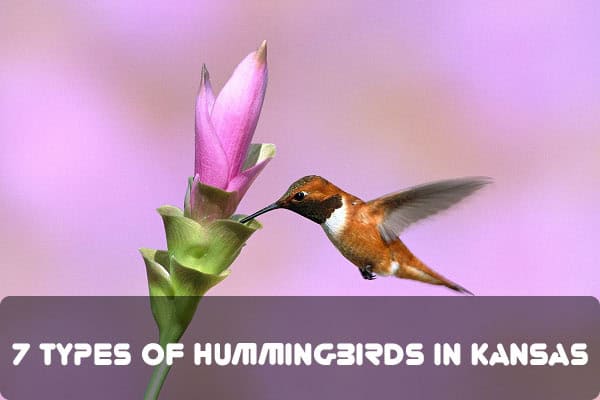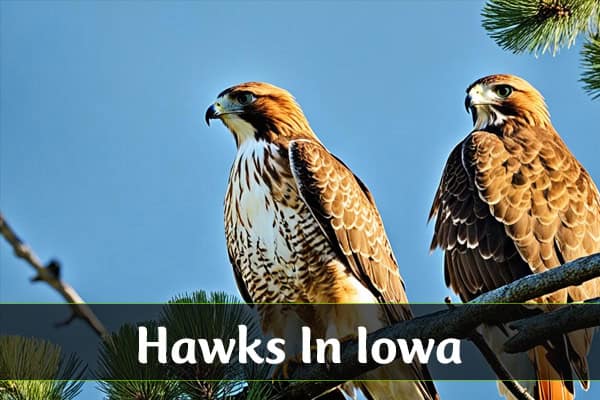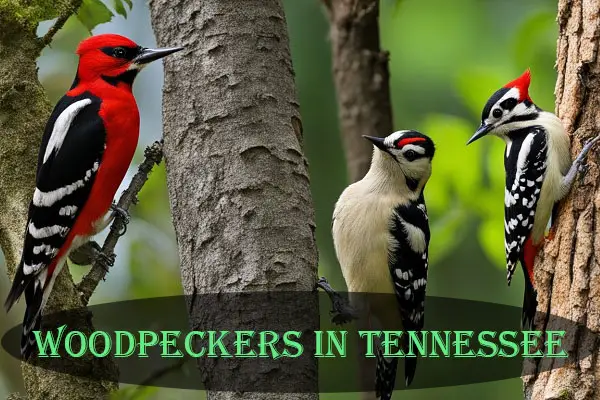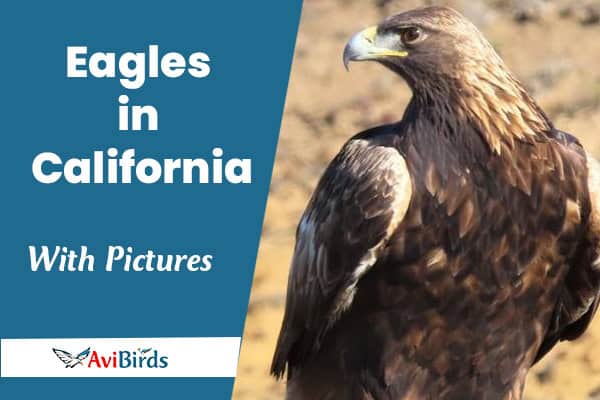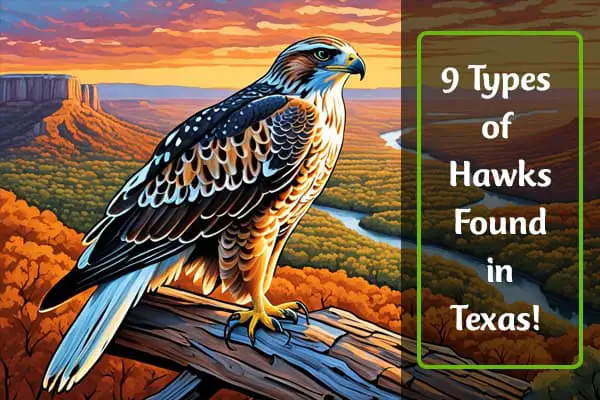8 Types Of Hawks in Tennessee (With Photos)
Tennessee is home to many cool hawks, and they’re super important for nature. I’ve found out that they help a lot by eating lots of rodents and keeping other bird numbers just right. This guide will show you some of the hawks you might see, like the big Northern Goshawk and the quick Cooper’s Hawk. You’ll learn how to spot them and understand why they’re so special. So, grab your binoculars, and let’s look for the hawks in Tennessee!
We’ll learn about 8 different types of Hawks in Tennessee!!
1. Red-shouldered Hawk
- Scientific name: Buteo lineatus
- Life span: 19 years
- Size: 16.9-24.0 in
- Weight: 17.1-27.3 oz
- Wingspan: 37.0-43.7 in
- Status: Least Concern
The Red-Shouldered Hawk is a beautiful and important part of Tennessee’s wildlife. These hawks love the state’s forests and swamps, where they build nests and hunt for food. They’re also really loyal, often sticking with the same mate and returning to the same nest every year.
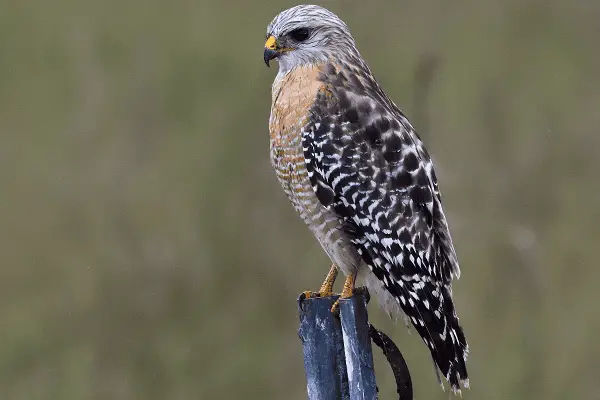
Their diet is pretty interesting too. They eat lots of small animals, but when it gets cold, they switch to eating crayfish and birds. Thanks to people working hard to protect them, their numbers are doing well now, which is great news for nature in Tennessee.
2. Northern Harrier
- Scientific name: Circus hudsonius
- Life span: 12 years
- Size: 18.1-19.7 in
- Weight: 10.6-26.5 oz
- Wingspan: 40.2-46.5 in
- Status: Least Concern
The Northern Harrier, Tennessee’s “Gray Ghost,” is a sight to behold with its owl-like face and distinct gray plumage. Known for its unique polygynous nature, the male may court multiple females with impressive aerial acrobatics.
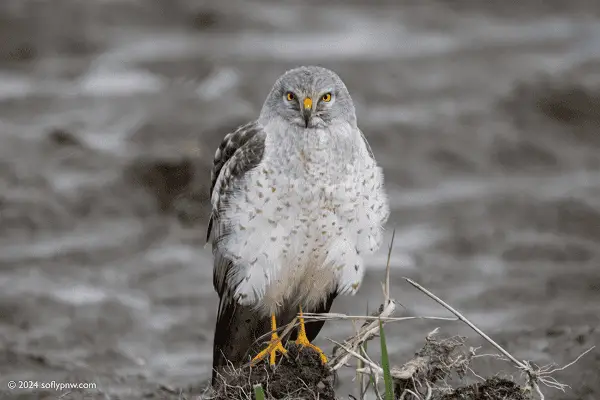
Starting nests on the ground in April, these raptors prefer open landscapes like moorlands and marshes. They dine mainly on small mammals, hunting with precision just above the terrain.
Despite challenges like habitat loss, the Northern Harrier’s wide range ensures its continued presence in the skies.
3. Red-Tailed Hawk
- Scientific name: Buteo jamaicensis
- Life span: 10-15 years
- Size: 19.7-25.6 in
- Weight: 31.8-51.5 oz
- Wingspan: 44.9-52.4 in
- Status: Least Concern
The Red-Tailed Hawk is a true Tennessean, with its fiery red tail and impressive wingspan. These adaptable hawks feel right at home in our woodlands.

Come February, the males put on a show, dancing in the sky to win their mates’ hearts. And when it’s mealtime, they’re not picky—small mammals, birds, whatever’s on the menu. Despite challenges, these hawks are spreading their wings across the state.
4. Cooper’s Hawk
- Scientific name: Accipiter cooperii
- Life span: 12 years
- Size: 14.6-15.3 in
- Weight: 7.8-14.5 oz
- Wingspan: 24.4-35.4 in
- Status: Least Concern
The Cooper’s Hawk is a skilled hunter found across North America, even venturing into Mexico. Its agility and flying prowess allow it to tackle prey larger than itself.

These hawks sport pale orange barring on their chests, often confusing birdwatchers with sharp-skinned hawks. Around birdfeeders, they’re stealthy predators, targeting unsuspecting birds—not seeds!
During the breeding season (starting in March), male Cooper’s Hawks perform impressive courtship flights. Once paired, they mark their territory with slow, deliberate wingbeats. Their nests perch high in trees, often repurposing old bird nests.
Their diet? Mostly small birds, caught mid-air or ambushed from branches. They also snack on mice and voles, less dramatically than their avian prey.
Cooper’s Hawks have had a wild ride in population trends. From a threefold increase to steep declines due to hunting, they’ve seen it all. Now, despite DDT setbacks, their numbers seem stable, with prey poisoning as their main threat.
5. Sharp-Shinned Hawk
- Scientific name: Accipiter striatus
- Life span: 5 years
- Size: 9.4-13.4 in
- Weight: 3.1-7.7 oz
- Wingspan: 16.9-22.1 in
- Status: Least Concern
The Sharp-Shinned Hawk is the smallest hawk in Tennessee and the whole country. They’re grayish on their back and orangy on their chest, which can make them hard to tell apart from another hawk called Cooper’s Hawk. But you can spot the difference by looking at their tail feathers. Because they’re small, they like to hide in forests, especially when they’re making babies.
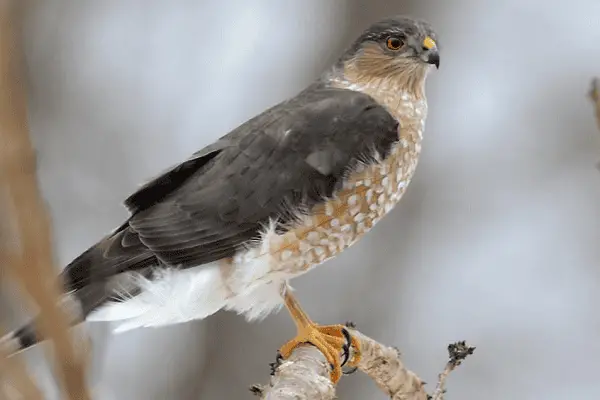
When it’s time to find a partner, the Sharp-Shinned Hawk puts on a show. They fly high above the trees, calling out to each other. The male does fancy tricks in the air to impress the female. They’re super secretive when they’re making nests, which they do in the thick parts of evergreen trees to stay hidden.
These hawks are great hunters. They mostly eat small birds and animals, just like their bigger relative, the Cooper’s Hawk. They’re sneaky, hiding in bushes or trees and waiting for prey to come close. They’re also skilled at catching birds while flying.
Back in the 1960s and 1970s, these hawks were in trouble because of chemicals people were using. But since those chemicals got banned, their numbers have gone up a lot. Plus, more people putting out bird feeders in their yards has given the hawks an easy way to find food, helping them recover even more.
6. Broad-Winged Hawk
- Scientific name: Buteo platypterus
- Life span: 12 years
- Size: 13.4-17.3 in
- Weight: 9.3-19.8 oz
- Wingspan: 31.9-39.4 in
- Status: Least Concern
The Broad-Winged Hawk is a common sight in Tennessee all year round, especially in the northern parts where they breed. People who love birds think watching their migration is really amazing.

In the fall, lots of these hawks come together in big groups as they get ready to fly to South America. They’re easy to spot with their dark brown bodies and light bellies that have lines across them.
These hawks are pretty cool. They make nests and have babies in the northern parts of Tennessee. In April, the male does a fancy flying dance to impress the female. Then they build their nest together in trees near the Tennessee River and up to Maine, but only in certain parts of Tennessee.
These hawks aren’t too picky about what they eat. Furthermore, They mostly go for small animals like voles, but they’ll also snack on things like frogs, bugs, birds, and lizards. They like to hide in low branches and swoop down on their prey, using their sharp claws to catch it.
7. Northern Goshawk
- Scientific name: Accipiter gentilis
- Life span: 6 years
- Size: 20-9-25.2 in
- Weight: 22.3-48.1 oz
- Wingspan: 40.5-46.1 in
- Status: Least Concern
The Northern Goshawk is just as good at flying through forests as the Cooper’s Hawk and Sharp-Shinned Hawk. It’s really good at hiding in the trees.

These hawks are shy and like to stay hidden under the trees. They usually live further north, but some can be found in the north of Tennessee, which is as far south as they go.
They’re easy to spot with their dark grey back and lighter belly with black stripes.
These hawks mate for life, like the Sharp-Shinned Hawk. When it’s time to find a partner, they fly around the forest together. The male does fancy dives and gives the female food to show off. The female builds the nest up high in tall trees, and the male brings her food while she’s sitting on the eggs.
Check Our Previous Articles:
| Eagles in California |
| How To Get Kids Interested In Birdwatching |
| Owls in Missouri |
| Eagles in North Carolina |
8. Rough-Legged Hawk
- Scientific name: Buteo lagopus
- Life span: Up to 15 years
- Size: 18-20 in
- Weight: 1.5-3.25 lbs
- Wingspan: 52-54 inches
- Status: Least Concern
The Rough-Legged Hawks is a special kind of hawk that only breeds in the far north and visits Tennessee in the winter.
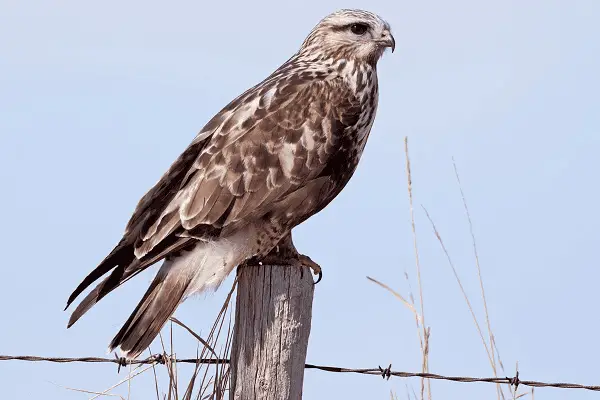
They have brown feathers with a lighter head and dark spots all over their body. What makes them stand out is a big dark spot on their belly. They also have feathers down to their toes, which is why they’re called “Rough-Legged.”
In the fall, these hawks look for places to nest where there are lots of animals to eat. They start breeding in May.
During mating season, the males and females do a flying dance together. They make their nests on cliffs using sticks, bones, and other stuff.
They mostly eat small mammals like voles and squirrels, but they also snack on birds, reptiles, and bugs. In the winter and when they’re flying, they’re more likely to go after birds like grouse and ducks.
Right now, they’re not in big trouble, but there are worries about them eating poisoned animals and losing their homes because of climate change. We don’t know a lot about how many there are, but we think their numbers are okay for now.
Frequently Asked Questions about Hawks in Tennessee
Q1. What is the most common hawk in Tennessee?
The Red-Tailed Hawks is the most common hawk in Tennessee.
Q2. What are hawks best known for?
Hawks are best known for their keen eyesight and hunting skills.
Q3. What is the largest bird in Tennessee?
The Bald Eagle is the largest bird in Tennessee.
Q4. What is the most famous hawk?
The Peregrine Falcon is often considered the most famous hawk.


